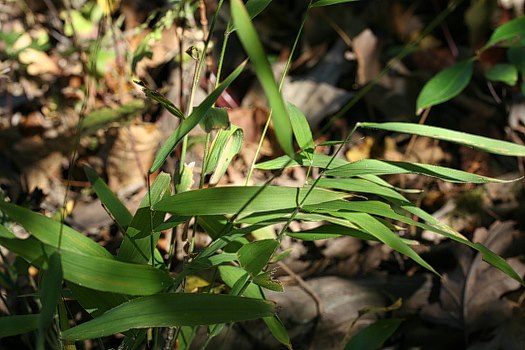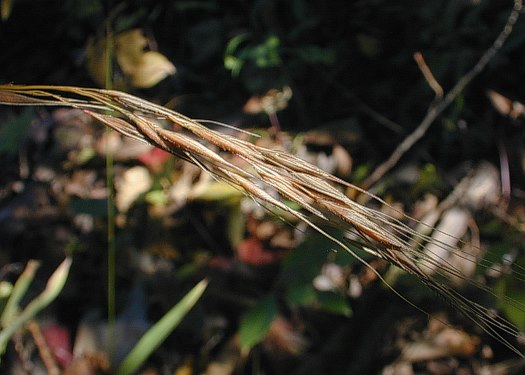Description: This perennial grass is 1-2' tall, more or less erect, and unbranched. The culm of each plant is light to medium green, terete, and mostly hairless. However, the swollen nodes and areas of the culm directly underneath them are densely covered with fine silky hairs (they are villous). Several alternate leaves occur along the length of each culm. The flat leaf blades are up to 6" long and ¾" across; they are dull medium green, tapering gradually at both their bases and tips. The upper surface of each blade is hairless, while the lower surface is slightly hairy. The leaf sheaths are dull medium green and sparsely pubescent, becoming hairy toward their apices; they are shorter than the internodes (length of the culm between two nodes).

Each fertile culm
terminates in a narrow inflorescence about 3-6" long, consisting of a
panicle of floral spikelets. The slender branches of this panicle are
ascending or appressed against the central stalk (rachis); they
terminate in single-flowered spikelets. Each spikelet consists of a
pair of tiny glumes at the base, a single lemma about 10 mm. long
(excluding its awn), and an inner palea enclosing the floret. The palea
is nearly as long as the lemma, and it is held in place by a
thread-like extension of the lateral branch (rachilla). The curved
lemma is linear-oblong with several longitudinal veins; these veins
have fine hairs. The awn of the lemma is 10-25 mm. long and straight.
The blooming period occurs during the summer; the florets are
cross-pollinated by the wind. Afterwards, the inflorescence turns
brown. The large grains are linear-oblong in shape. The root system is
rhizomatous and fibrous. Small colonies of plants are often produced by
the rhizomes.
Cultivation:
The preference is light shade, mesic conditions, and soil containing
loam, sandy loam, or some rocky material.
Range & Habitat:
Long-Awned Wood Grass is uncommon to occasional throughout Illinois
(see Distribution
Map); it is native to the state. Habitats are moist to
slightly dry deciduous woodlands.
This grass is found primarily in high quality woodlands, rather than
those with a history of disturbance.

Faunal
Associations: Little
is known about floral-faunal relationships for this grass. The larvae
of a moth, Dicranoctetes brachyelytrifoliella, mine
the leaves of this
grass, and the larvae of a butterfly, Enodia anthedon
(Northern Pearly Eye), also feed on the foliage (Braun, 1948; Opler
& Krizek, 1984). Because the awns of the
lemmas can stick to fur, mammals probably help to distribute the seeds.
Photographic Location:
A sandy wooded area near the Heron Boardwalk in Vermilion County. The
photographs were taken during the early autumn.
Comments:
Long-Awned Woodland Grass is one of the more unusual woodland grasses
that is not often described. It somewhat resembles one of the woodland Bromus
spp. (Brome Grasses), but its spikelets are single-flowered.
Both the lemmas and awns are unusually long. Because the foliage is
quite attractive and persists through the summer, Long-Awned Woodland
Grass should be cultivated more often. Other common names of this grass
are False Brome and Bearded Short Husk.